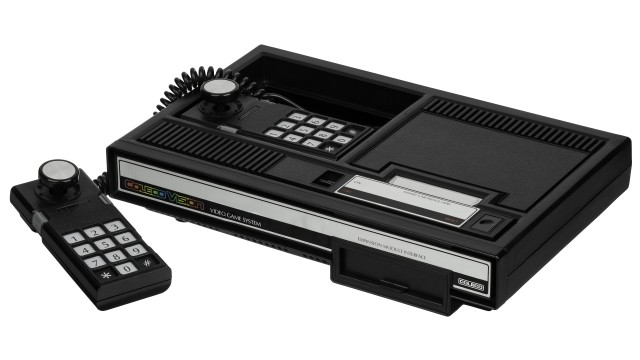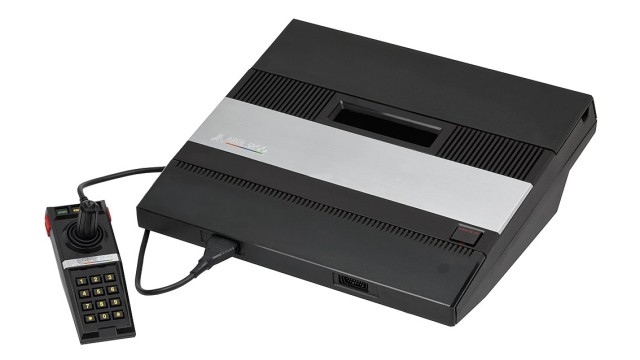
ColecoVision
Launches: 1982
Units sold: 2 000 000
Generation: 2nd
 ColecoVision technical specifications
ColecoVision technical specifications
CPU: Zilog Z80 (8 bits)
Memory: None
 ColecoVision video specifications
ColecoVision video specifications
ColecoVision graphics capabilities.
Video chip: TMS9928A (NTSC) / TMS9929A (PAL)
Video connection:
 ColecoVision audio specifications
ColecoVision audio specifications
ColecoVision sound capabilities.
Audio chip: SN76489
Audio mode:
 Controllers of ColecoVision
Controllers of ColecoVision
 ColecoVision games support
ColecoVision games support
Support: Cartridge
ColecoVision games
Games library:
ColecoVision story
The ColecoVision console, released in 1982, was a significant player in the early 1980s video game market. Its creation, development, launch, and market reception reflect both the ambition of its parent company, Coleco Industries, and the volatile nature of the video game industry during that period.
The creation of the ColecoVision can be traced back to Coleco Industries' desire to diversify its business and capitalize on the booming video game market. Coleco, originally known for manufacturing leather products and later toys, had experienced considerable success with its Telstar series of home consoles in the late 1970s. However, by the early 1980s, the company recognized the need to innovate and produce a more advanced console that could compete with the likes of Atari and Intellivision. The video game market was rapidly evolving, with consumers demanding more sophisticated graphics, better sound, and a broader range of gameplay experiences. Coleco’s management saw an opportunity to enter this competitive space with a console that would surpass the technical limitations of existing systems.
In the initial phase of development, Coleco set out to create a console that would offer arcade-quality graphics and gameplay in a home setting. To achieve this, the company licensed the Zilog Z80A microprocessor, a powerful chip that was widely used in arcade machines at the time. This decision was crucial, as it allowed the ColecoVision to run games that closely resembled their arcade counterparts, a key selling point that distinguished it from other consoles on the market. The design of the ColecoVision also included a robust graphics chip, the Texas Instruments TMS9918A, which enabled the console to produce colorful, detailed sprites and backgrounds that were a significant leap forward from the blocky, simplistic graphics of earlier systems.
Another important aspect of the ColecoVision’s development was the decision to include a dedicated sound chip. This chip, also from Texas Instruments, provided the console with superior audio capabilities, allowing for more complex and varied sound effects and music. The combination of advanced graphics and sound gave the ColecoVision a distinct edge, positioning it as a premium product in the home console market.
During this time, Coleco also recognized the importance of securing strong software support for the ColecoVision. The company aggressively pursued licensing deals with major arcade game developers, aiming to bring popular arcade titles to the home console market. This strategy was instrumental in the early success of the ColecoVision, as it allowed the system to launch with an impressive library of recognizable games. Coleco struck a particularly important deal with Nintendo to include Donkey Kong as a pack-in game with the console. This was a major coup for Coleco, as Donkey Kong was one of the hottest arcade games at the time, and its inclusion gave the ColecoVision a significant boost in consumer interest.
The launch of the ColecoVision in August 1982 was a carefully orchestrated event designed to position the console as a cutting-edge entertainment system. Priced at $175, the ColecoVision was marketed as a premium product, aimed at consumers who were looking for a high-quality gaming experience. The system came bundled with the Donkey Kong cartridge, which not only showcased the console's impressive capabilities but also provided an immediate draw for fans of the popular arcade game. The initial marketing campaign emphasized the ColecoVision’s ability to deliver arcade-quality graphics and gameplay, with comparisons to the arcade versions of games being a key selling point.
The timing of the ColecoVision’s release was also strategic. By mid-1982, the video game market was expanding rapidly, with new players entering the field and consumer demand at an all-time high. Coleco’s decision to launch the ColecoVision during this period allowed it to capture the attention of gamers who were eager for the next big thing in home entertainment. Early reviews of the ColecoVision were overwhelmingly positive, with critics praising the console’s superior graphics, sound, and overall performance. The inclusion of Donkey Kong as a pack-in game was also widely regarded as a brilliant move, as it immediately established the ColecoVision as a must-have item for video game enthusiasts.
The market reception of the ColecoVision was initially very strong. Within a few months of its release, the console had sold over 500,000 units, making it one of the fastest-selling video game systems of its time. The ColecoVision’s success was bolstered by a steady stream of high-quality game releases, many of which were ports of popular arcade titles. The console’s library quickly grew to include games like Zaxxon, Turbo, and Venture, each of which demonstrated the system’s technical prowess and helped to solidify its reputation as the premier home console for arcade-style gaming.
In addition to its impressive library of games, the ColecoVision benefited from a number of peripherals and expansion modules that extended its capabilities. One of the most notable was the Expansion Module #1, which allowed the ColecoVision to play cartridges from the Atari 2600, significantly expanding the system’s game library and making it an even more attractive option for consumers. This move was particularly strategic, as it allowed Coleco to tap into the large base of Atari 2600 owners who were looking for an upgrade but didn’t want to abandon their existing game collections.
Despite its strong start, the ColecoVision’s success was short-lived. The video game market of the early 1980s was highly volatile, and by 1983, the industry was entering a period of significant turmoil. The market had become oversaturated with consoles and games, many of which were of poor quality. This led to a loss of consumer confidence and a sharp decline in sales across the industry, a period now known as the video game crash of 1983. The crash had a devastating impact on ColecoVision, as well as on other console manufacturers.
As the video game market collapsed, Coleco’s fortunes quickly declined. Despite its early success, the ColecoVision was unable to sustain its momentum in the face of the industry-wide downturn. The company attempted to diversify its offerings by introducing products like the Adam computer, which was designed to be compatible with the ColecoVision. However, the Adam was plagued by technical problems and failed to gain traction in the market, further exacerbating Coleco’s financial difficulties.
By 1984, Coleco had ceased production of the ColecoVision, and the company shifted its focus back to its core toy business. The video game crash had claimed another victim, and the ColecoVision, despite its technical innovations and early market success, was unable to survive the harsh realities of the collapsing market. In total, approximately two million ColecoVision units were sold, a respectable number given the circumstances, but far short of what might have been possible in a more stable market environment.
In the years since its discontinuation, the ColecoVision has come to be regarded as a classic console, fondly remembered by those who experienced it during its brief but impactful run. Its legacy lies in its role as a bridge between the simpler, early consoles of the 1970s and the more advanced systems that would emerge in the mid-1980s and beyond. The ColecoVision demonstrated the potential for home consoles to deliver arcade-quality experiences, a standard that would influence the development of future generations of video game systems.
Today, the ColecoVision is celebrated by retro gaming enthusiasts and collectors, who appreciate the system’s innovative design, impressive game library, and the role it played in the evolution of the video game industry. Despite its short lifespan, the ColecoVision remains an important chapter in the history of video gaming, representing both the promise and the pitfalls of an industry that was still finding its footing in the early 1980s.
Previous Coleco console: Telstar


